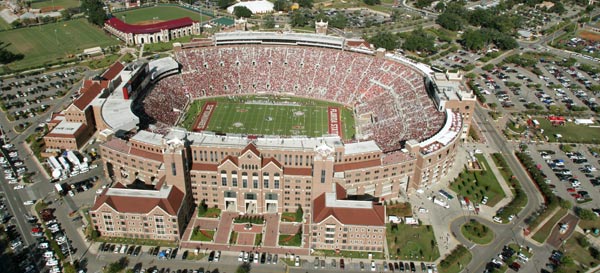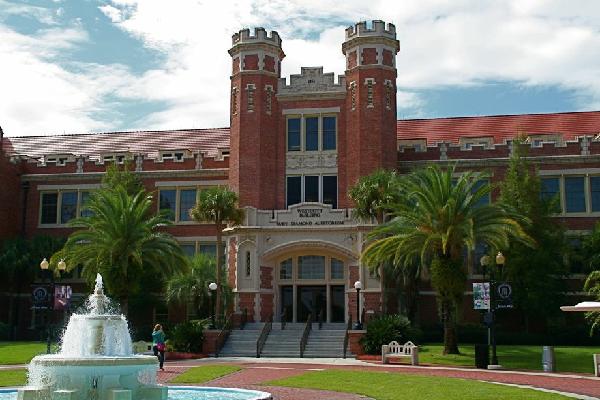Architectural beauty informs Florida State’s athletics identity
By Charlie Barnes, Executive Director - Seminole Boosters
A new pyramid has been uncovered in Egypt. "Uncovered" doesn't sound right; Pyramids' glories were to be displayed above ground. Nevertheless, a new pyramid was discovered last November buried beneath the sands of Saqqara.
They are among the oldest manmade masonry structures. Archaeologists still debate the range of purpose pyramids served, with their precise lines and polished limestone sides that blazed like suns on the Egyptian plain.
The architect of the original pyramids was made into a god by the Egyptians, but there is no record of what guided his thoughts, or why the structures were so vast. The pyramids at Giza remain among the largest structures ever built by man.
Pyramids marked the beginning of civilization as we recognize it. Is it possible those ancient people, overwhelmed by the vast night sky and the random cataclysm of life in the early Bronze Age decided to shake their fists at the universe? We too are important, they might have said, not just the Nile and the stars. See what we have made.
Why do the pyramids fascinate us after nearly 50 centuries? It is because they are beautiful. We are hard-wired to recognize beauty; we are drawn to it. A University of Exeter study published in 2004 showed that newborns as young as five hours old "prefer human faces that adults also consider attractive." And the newborns are less interested in faces that adults consider unattractive.
The author surmises that "just as a fetus develops eyes and lips, it also develops knowledge of what a face is 'supposed' to look like based on an evolution-informed average of what all human faces look like."
Apparently, standards of beauty vary only slightly over time and culture. The psychologist says, "Show an insular European two African faces, and the one the European picks as more attractive is also the one an African person would pick."
Proportion is the key. Proportion is the cornerstone of architectural design and the genetic key to our concept of beauty.
Architecture students understand the power of architecture to influence the social landscape. For example, metropolitan American courthouses usually contain a series of courtrooms. Most are just simple rooms, outfitted for the pedestrian business of the legal trade. But there is usually one majestic salon outfitted with 20-foot fluted Corinthian columns and mahogany appointments designed to impress all with, as they say, the majesty of the law. The more grandiose the venue, the more important you may assume the proceedings to be.
Many Florida State alumni wince at the dissonance between the Gothic architecture of the old campus and some of the ghastly 1960s constructions that line West Tennessee Street. Built during the university's rapid expansion, they appear to have been raised up as cheaply and as quickly as possible.
Until it was washed and painted just a year or so ago, McCollum Hall was six stories of filth-streaked slabs of raw concrete, more suggestive of a Soviet mental facility than a college residence hall. It is an ugly building, and we know that it is ugly the moment we see it.
Bad architecture is not beautiful. We want beauty. We turn to beauty as the bud turns toward the sun. Beauty uplifts us and reassures us, and the beauty of our buildings shapes our lives and our vision of who we are.
American college football stadiums are where we wear our colors and engage in ritual combat with neighboring tribes. When the construction of University Center began more than 20 years ago, the collegiate Gothic (technically it is Jacobean) design was deliberately chosen to underscore who we wish to be. The design not only reflects but also shapes the personality of our fan base.
Like most stadiums, Doak Campbell began life as a shallow dish. As the masonry walls of University Center rose around it, the stadium became a thing of beauty. Doak Campbell was not designed — as some stadiums are — to hold in the heat, to contain and amplify the noise. It was not designed to be raw and ugly — as some are — in order to project power and to intimidate.
 |
Doak S. Campbell Stadium - 1953 |
No, if Doak Campbell does intimidate at first glance, it is due to the breathtaking scale and grandeur of its surroundings. I’m told University Center is the largest contiguous brick construction in the history of the United States. It is beautiful. Classic. And it was intended to be so.
 |
Bobby Bowden Field at Doak S. Campbell Stadium |
Our architecture is a reflection of who we are and who we see ourselves to be as a Florida State University community.
The hill where Westcott stands is the oldest continuous site of higher education in the state of Florida. Since our founding, our buildings for the most part have echoed the classic architecture identified with university education for a thousand years. Restoration of buildings and interiors on our main campus has substantially enriched the experience of our undergraduates.
 |
Wescott Building |
President Talbot "Sandy" D’Alemberte directed that all construction at Florida State follow the established Jacobean architectural standard. T.K. Wetherell continued the directive, and Seminole Booster President Andy Miller made certain that University Center was the centerpiece of that theme.
In an astonishingly short time, our entire park of Seminole athletics facilities has been built, all cloaked in the magnificent Jacobean brick and stone. The new College of Medicine and a wide range of new dorms and student services buildings also echo the timeless standard.
 |
College of Medicine Building |
Think of architecture as our inheritance as alumni, as a way of linking ourselves with the genetic memories of our university. Through classic architecture our forebears whisper to us that both past and future do share a familiar and reassuring landscape.
The sands do cover everything in the end. But beauty endures and is the noblest yearning of mankind.